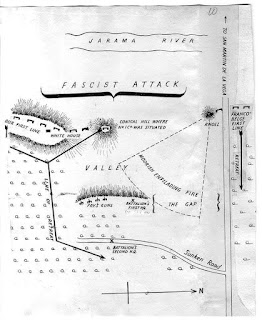Suicide Hill
This article originally appeared in The Journal
“There's a place in
After
failing to take Madrid by frontal assault General Francisco Franco gave orders for the road
that linked the city to the rest of Republican Spain to be cut. A Nationalist
force of 40,000 men, including men from the Army of Africa, crossed the
General
José Miaja sent three International Brigades including the Dimitrov Battalion and the British Battalion to the
XVth
International Brigade Feb. 1937
CO – General Gal
Brigade Political Commissar – Valdimir Copic
Chief of Staff – George Nathan
Brigade Intelligence Officer - Col. Stephanovitch
Brigade Communications Officer – Yurani Yuraslov
British Battalion (Winteringham)
Dimitrov Battalion (Josip Tito)
Franco-Belge Battalion
Lincoln Battalion (500 Americans joined the Brigade on
Feb. 23)
2 – WW1 French 75s
1 – English 5.2 inch howitzer
9 – Russian tanks (un-identified but probably T26s)
The
British Battalion
Originally titled
Saklatavala Battalion, but later changed to Clement Attlee for political
motives. Kitted out at the old Guardia Civil barracks in
Each man was issued with
a “Russian Rifle” (probably the Mosin-Nagant 1891 model) with bayonet. The
battalion was also given locally manufactured grenades – made from a short
length of mild-steel pipe with half a stick of gelignite inside with a short
fuse!
British
Battalion 12th Feb. 1937
(Approx.
600 men)
CO – Tom Winteringham
Political Commissar – George Aitken
Communications & Battalion scouts
Medical detail
2nd company (MG) – Harry Fry
3rd company – William Briskey
4th company - Bert Overton
The attack plan was for
the three rifle companies to advance and envelop the hill before moving on
towards the river beyond.
Moroccan
Regulares Grupo 1936/37
3
x Tabors (Battalions) each of:
HQ
3
X Rifle Companies (below)
1
X Machinegun Company (below)
Company
HQ usually commanded by a Teniente (Lieutenant)
3
X Secciones (platoons) each of:
HQ
commanded by a Sargento (sergeant)
3
X Pelotones of a Cabo (corporal)
+ 8
men
MG Company (all Spanish)
A
Captain, two lieutenants, a sub lieutenant, four sergeants, four NCOs, a
trumpeter, two first class soldiers, and forty two soldiers
The company had nineteen mules for the transport of four Hotchkiss machine guns.
The attack was a disaster;
minutes after the companies began their advance they were met by a storm of
accurate artillery and heavy machine gun fire. No1 company with most of the
more experienced men and a good leader (Kit Conway), dug-in on the reverse
slope of their little hill. No3 company lost both its officer and second in
command along with over half its strength. No4 Company was worse as its
commander (Overton) was totally unsuitable and proved incapable of either
giving or carrying out his orders, casualties were high. To make things worse
the Browning MGs had been supplied with the wrong belts – so would not fire and
the Chauchats were prone to clogging with mud and proved near useless in
combat.
The Moors of course were well supported by artillery and MGs, but also were highly skilled experienced soldiers. The moved forward in small groups using the terrain, one group covering whilst another advanced, in this way they were able to maintain a continuous and accurate stream of fire against the already shocked and disorganised British.
Battalion
CP (Wintringham) about 30 men from HQ and No3 Company
under Andre Diamond (assistant Quartermaster)
No2
Company (Fry) 8 Maxims, 80 men
No4
Company (Overton) 40 men
No1 company (Conway) 50 men
After much arguing
Wintringham with the aid of George Aitken the Political Commissar organised the
attack - Overton on the left; Conway on the right and Diamond through the
centre; each group with roughly 40 men, supported by Harry Fry and his Maxims.
The advance never got underway however, the moment the British scouts began to
filter through the olive groves, the Moors opened up with machine guns and then
their supporting artillery joined in. The attack was halted before it began,
with no signs of the tanks or aircraft which had been promised or the Lister
Brigade either.
About an hour into the action without warning the redoubt of No2 Company was overrun (it turned out that Overton had withdrawn on the left without notifying anyone and the Moors had been able to out flank the position). Wintringham was wounded in a suicidal “over the top” attempt to retake the position which caused many casualties only the arrival to two Russian tanks prevented the Moors from breaking through although these could not retake the position.
Wargaming this battle
The first days attack
could be run as it was historically; I would suggest an umpire play the
Nationalists. On paper the British Battalion looks quite strong with the
Strossers and Brownings in each platoon. However the lack of training (only No1
Company can really be considered trained) and the poor quality officers (again
only No1 Company has an experienced leader); combined with these useless
weapons and the strength of the opposition make the chances of any success
slim. If you want to give the British a chance you could allow the Brigades
artillery to assist or add a Russian tank or two.
For the second day maybe the best way to run it would be a Nationalist assault on the dug-in Battalion along the sunken road. The Battalion is very weak so I would consider adding some troops from the Lister Brigade as well as some artillery and the Russian tanks. Even with all this support the Moors with their artillery and overwhelming numbers will be hard to stop.
Sources
Crusade in
The Spanish Civil War by
Tropas Regulares
Indigenas by Delfin Salas (ISBN 84-86629-17-9)
Micromark list – S10
Article from Military
Modelling “The Spanish Civil War” by Charles Esdaile
I’d like to thank Martin Rapier and John Bruce of Force of Arms for their help with Moroccan organisations


No comments:
Post a Comment